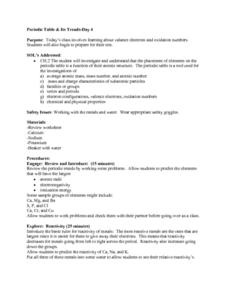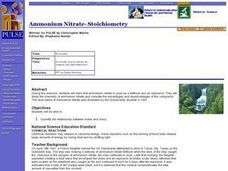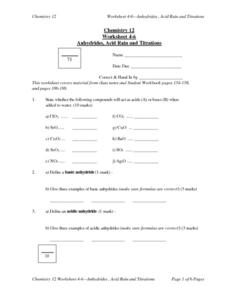Curated OER
Water Ph
Eighth graders study the concepts of acids, bases, salts and neutralization. They discuss steam adoption program, acid rain and other ecological implications. They use indicators to obtain pH values of household chemicals and to...
American Chemical Society
Comparing the Amount of Acid in Different Solutions
Upcoming chemists use chemical reactions to determine relative pH in two different acids. This is a terrific lesson plan for middle schoolers that can stand alone as a practice in precision and lab skills, or as part of the unit on...
Curated OER
Phases of Matter
Students describe the motion of solids, liquids and gases. In this chemistry lesson, students describe how temperature affect motion of the particles. They determine the physical properties of each phase.
Curated OER
Kitchen Electrophoresis
Students investigate and explain the differences active transport versus passive transport. This instructional activity includes an individual and group activity. The basic steps of electrophores is the focus of inquiry. Identification...
Curated OER
Chemical Bonding
Eighth graders identify the three main types of chemical bonds. In this chemistry instructional activity, 8th graders draw Lewis dot diagrams of elements and determine the bond formed. They create a model water molecule.
Curated OER
Interpreting pH
In this pH worksheet, students read about pH and the concentration of ions in solutions that are acidic and basic. They answer four questions about pH and determine the concentration of hydronium ions and the pH given concentrations of...
Curated OER
The Measurement Of Acids And Bases
Middle schoolers investigate the differences in chemistry between an acid and a base substance. They conduct measurements based upon the pH scale and then answer the questions included in the lesson. The information for the lesson is...
Curated OER
Acid Stomach
Students develop an understanding of how aspirin works and how understanding it's interaction with other chemicals in the body aided doctors in medical research. They complete a lab that compares the reaction of regular aspirin and...
Curated OER
Endothermic and Exothermic Lab
In this endothermic and exothermic reactions worksheet, students experiment with water and a salt of choice to determine if heat is absorbed or released in the reaction. Students take the temperature of their solution over a 2 minute...
Curated OER
Periodic Table And Its Trends - Day 4
Guide your chemistry class through the periodic table so that they are able to identify atomic radii, electronegativity, and ionization energy. Give them three metals to place in water to observe reactivity. Teach them to write electron...
Curated OER
Ammonium Nitrate- Stoichiometry
Students quantify the relationship between moles and mass. They comprehend that ammonium nitrate is used as a fertilizer and an explosive. Students study the chemistry of ammonium nitrate and consider the advantages and disadvantages of...
Curated OER
DNA Fingerprinting through a Chemistry Lens
Students explore DNA and restriction enzymes using fragments of DNA separated by electrophoresis on an agarose gel. They analyze the results to see "whodunit".
Curated OER
Introduction to Neutraliization
Students explore acids and bases and the process of neutralization.T hey practice volume measurements and observe the neutralization of an acid
directly through bubble formation and indirectly through indicator color changes.
Curated OER
Acids and Bases
In this acids and bases worksheet, students complete 32 fill in the blank and short answer questions on acidity or alkalinity. They color molecular diagram according to the key.
Curated OER
Oxidation: How Can It Be Proved?
Students explore the process of oxidation. In this lesson plan about oxidation, students observe four different demonstrations. Students watch examples of oxidation in order to understand the process. Students discuss the chemical...
Curated OER
Introductory Lesson on How pH Levels are Determined
Students explore pH levels of different substances. In this lesson about pH, students work together in three to four groups to test substances. moving between three different stations performing tests on the substances to determine...
Curated OER
The Mole as a Large Number or an Exercise in Dimensional Analysis
Students complete an activity and make "provable estimates." In this dimensional analysis activity students use dimensional analysis and complete an activity.
Curated OER
Anhydrides, Acid Rain and Titrations
In this chemical compounds worksheet, students determine is compounds will act as acids or bases when added to water. Students compare basic, acidic, and amphoteric anhydrides. This worksheet has 15 fill in the blank, 2 short answer...
Curated OER
What is Everything Made of?
Students observe a demonstration on how we see space between water molecules. In this experimental lesson plan students discover what elements make up the things around them and discuss what they learned.
Curated OER
Rules for Balancing REDOX Equations: (Half-Reaction Method)
In this chemistry worksheet, students read the instructions of how to work with the following: acidic and basic solutions, total and net ionic equations, and how to relate these to each other.
Curated OER
pH Pre-Lab: Acids and Bases
In this chemistry lab, students determine whether or not their saliva is acidic, basic, or neutral. After completing their test, they answer 6 analysis questions.
Curated OER
Limiting Reactant
In this chemistry worksheets, students calculate the amount of reactants and products are produced by the given equations. Students also calculate the number of moles as well as the mass of the given compounds.
Curated OER
WS 8.9 Presentation Questions
In this mixtures worksheet, students answer twenty three questions about student presentations on topics such as amalgams, homogenized milk, antifreeze and coolants, soaps and detergents and water softeners.
Curated OER
Seltzer Breath
High schoolers investigate "indicator" (Bromothymol Blue or BTB) to test for the presence of certain chemicals in liquids and gases. They compare distilled water and seltzer water for presence of carbon dioxide.

























